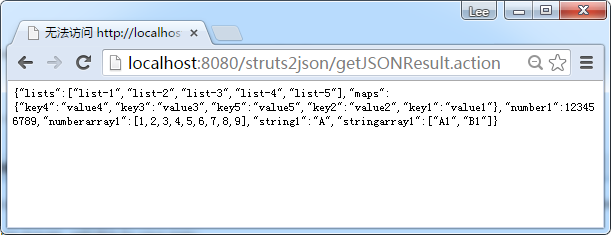Struts2和JSON實例
在這個Struts2例子,將學習如何通過「struts2-json-plugin.jar」庫將對象轉換爲JSON格式的數據。
1. Action (JSON)
這是一個將被轉換成JSON格式的 Action 類。
package com.yiibai.common.action;
import java.util.ArrayList;
import java.util.HashMap;
import java.util.List;
import java.util.Map;
import com.opensymphony.xwork2.Action;
public class JSONDataAction{
private String string1 = "A";
private String\[\] stringarray1 = {"A1","B1"};
private int number1 = 123456789;
private int\[\] numberarray1 = {1,2,3,4,5,6,7,8,9};
private List<String> lists = new ArrayList<String>();
private Map<String, String> maps = new HashMap<String, String>();
//no getter method, will not include in the JSON
private String string2 = "B";
public JSONDataAction(){
lists.add("list1");
lists.add("list2");
lists.add("list3");
lists.add("list4");
lists.add("list5");
maps.put("key1", "value1");
maps.put("key2", "value2");
maps.put("key3", "value3");
maps.put("key4", "value4");
maps.put("key5", "value5");
}
public String execute() {
return Action.SUCCESS;
}
public String getString1() {
return string1;
}
public void setString1(String string1) {
this.string1 = string1;
}
public String\[\] getStringarray1() {
return stringarray1;
}
public void setStringarray1(String\[\] stringarray1) {
this.stringarray1 = stringarray1;
}
public int getNumber1() {
return number1;
}
public void setNumber1(int number1) {
this.number1 = number1;
}
public int\[\] getNumberarray1() {
return numberarray1;
}
public void setNumberarray1(int\[\] numberarray1) {
this.numberarray1 = numberarray1;
}
public List<String> getLists() {
return lists;
}
public void setLists(List<String> lists) {
this.lists = lists;
}
public Map<String, String> getMaps() {
return maps;
}
public void setMaps(Map<String, String> maps) {
this.maps = maps;
}}
3. struts.xml
要輸出JSON數據,需要聲明一個包,它擴展「json-default」,會將結果類型轉爲「json」。
4. 實例
訪問動作URL時,JSONDataAction屬性將被轉換成JSON格式。
*http://localhost:8080/struts2json/getJSONResult.action

*
JSON 格式 …
{
"lists":["list-1","list-2","list-3","list-4","list-5"],
"maps":
{
"key4":"value4","key3":"value3","key5":"value5","key2":"value2","key1":"value1"
},
"number1":123456789,
"numberarray1":[1,2,3,4,5,6,7,8,9],
"string1":"A",
"stringarray1":["A1","B1"]
}
希望這個簡單的例子可以瞭解JSON插件在Struts2是如何工作的有一個總體的思路。不過,還是有很多有用的參數不包括在這裏,請務必閱讀 Struts2 JSON插件文檔 以獲取更多詳細信息。
下載源代碼(struts2json) – http://pan.baidu.com/s/1bnv8l9X